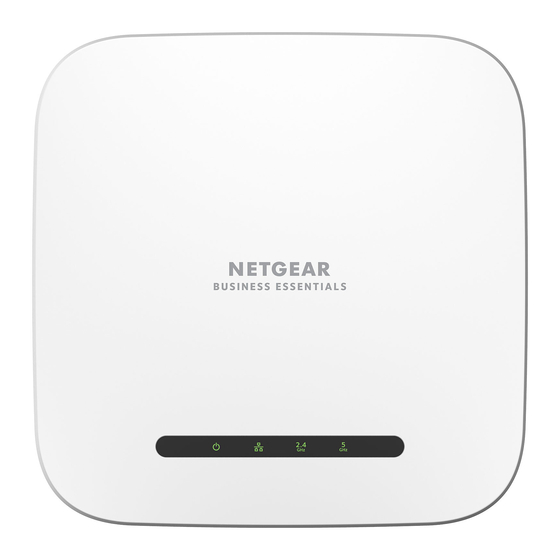
Summarization of Contents
Hardware Overview
Additional documentation
Documents available for download from NETGEAR support.
Unpack the AP
Details the items included in the WAX220 AP package.
Top panel with LEDs
Describes the LEDs on the top panel of the AP.
Hardware interfaces
Details the physical ports and buttons on the AP.
Label
Information found on the AP label.
Installation and Initial Login
Set up the AP in your network
Guide on connecting the AP to your existing network.
Initial login process
Steps for the first-time login and initial configuration.
When to use aplogin.net and when to use the assigned IP address
Clarifies how to access the AP's interface.
Find the IP address of the AP
Methods to locate the AP's IP address.
Log in to the AP after you complete the initial login process
How to log in after initial setup.
Change the language
How to change the device UI language.
Join a user WiFi network on the AP
Connecting devices to user WiFi networks.
Manage the Wired Network Settings
Set a static IPv4 address
How to configure a fixed IP address for the AP.
Reenable the DHCP client of the AP
Restoring automatic IP address assignment.
Use an existing management VLAN
Configuring the AP with a management VLAN.
Manage Basic WiFi Settings
User WiFi networks
Settings for user-created WiFi networks.
Management WiFi network
Information about the dedicated management network.
Change the AP’s device name
Renaming the AP.
Manage Advanced WiFi Settings
Hide the name of a user WiFi network
Disabling SSID broadcast for security.
Isolate clients of a user WiFi network without exceptions
Preventing WiFi clients from communicating with each other.
Isolate clients of a user WiFi network and set exceptions
Client isolation with specific exceptions.
Enable VLAN isolation for a user WiFi network and set a VLAN ID
Isolating WiFi traffic using VLANs.
Enable fast roaming
Improving mobile device roaming performance.
Manage access to a user WiFi network based on a client’s MAC address
Filtering clients by MAC address.
Manually block a WiFi client from a user WiFi network
Blocking specific WiFi devices.
Remove a WiFi client from an access control list
Removing devices from ACLs.
Set up a WiFi on/off schedule for a user WiFi network
Scheduling WiFi network availability.
Change the DHCP server settings for guest WiFi networks
Configuring IP address ranges for guest networks.
Manage the WiFi Radio Settings
Change the country and region of operation
Setting the operational country and region.
Manage the channel high throughput mode
Adjusting channel bandwidth for performance.
Manage the WiFi channels
Selecting WiFi channels to reduce interference.
Manage the radio transmit power
Adjusting the power level of WiFi radios.
Change the minimum bit rate
Setting the minimum data rate for clients.
Manage client limits
Setting the maximum number of connected clients.
Manage the multicast and unicast streams to WiFi clients
Configuring stream conversion for clients.
Manage the 802.11ax mode for the 2.4 GHz radio
Enabling or disabling WiFi 6 mode on 2.4 GHz.
Enable band steering
Steering dual-band devices to optimal bands.
Maintain the AP
Update the AP firmware
Installing new firmware for the AP.
Back up or restore the configuration file
Saving and loading AP settings.
Change the AP login password
Modifying the AP's administrative password.
Manage the date and time settings
Configuring AP date, time, and time zone.
Manage Universal Plug and Play
Enabling or disabling UPnP for device discovery.
Control the LEDs
Managing AP LED behavior.
Restart the AP from the device UI
Rebooting the AP via the user interface.
Schedule the AP to automatically restart
Setting up scheduled AP reboots.
Reset the AP to factory default settings
Restoring the AP to its original configuration.
Monitor the AP and its Network Connections
Display the AP device, memory, LAN, and WiFi status information
Shows device, memory, LAN, and WiFi status details.
Display the WiFi connections
Lists connected WiFi devices.
Display the CPU, user WiFi network, and LAN traffic loads
Shows CPU, network, and LAN traffic usage.
Scan for neighboring access points and WiFi routers
Detects nearby WiFi networks.
Logs
Accessing and managing system logs.
Set up email alerts
Configuring email notifications for AP events.
Perform Diagnostics and Troubleshooting
Send a ping
Checks network connectivity to an IP address.
Send a traceroute request
Traces packet path to a destination.
Send a name server lookup request
Performs DNS lookups.
Perform a speed test for the connection to a WiFi client
Tests WiFi connection speed.
Quick tips for WiFi troubleshooting
Common tips for resolving WiFi issues.
Troubleshoot with the LEDs
Diagnosing issues using AP LEDs.
Troubleshoot the WiFi connectivity
Resolving problems with WiFi connections.
Troubleshoot Internet browsing
Resolving issues with web access.
You cannot log in to the AP over a LAN connection
Fixes for login issues via LAN.
Changes are not saved in the device UI
Addresses issues with saving settings.
Troubleshoot your network using the ping utility of your computer or mobile device
Using computer ping for network diagnostics.
















Need help?
Do you have a question about the WAX214PA and is the answer not in the manual?
Questions and answers